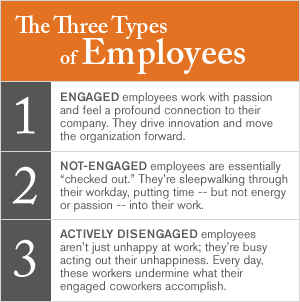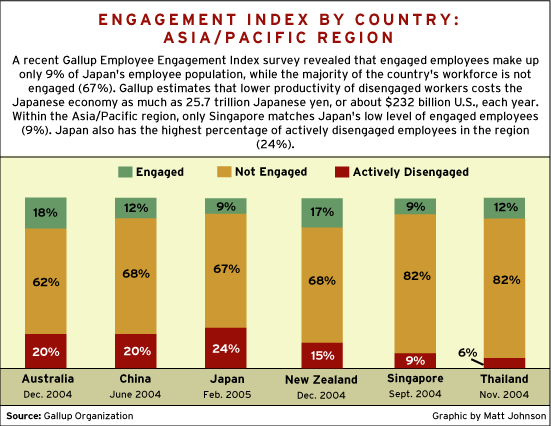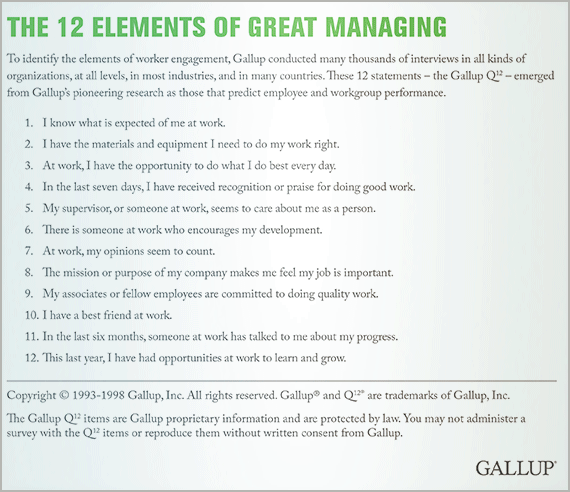As Japan's economy continues to stagnate and various economic reports send mixed signals, the country's policymakers and business leaders struggle to take actions needed to spur a robust economic recovery.
They've got their work cut out for them. The Economist notes that exports to China, which fueled much of Japan's growth between early 2002 and last year, have slackened. And the improved domestic economy, which helped boost the first quarter's GDP figure, isn't secure.
What's more, if government and business leaders are counting on Japanese employees to help boost an economic recovery, they're sure to be disappointed. Only 9% of Japanese employees are "engaged" at work -- that is, psychologically committed to their jobs and their employers. That figure, a key finding from The Gallup Organization's most recent Employee Engagement Index survey of Japan's workforce, has remained virtually unchanged over the past five years.
The survey also reveals that 67% of Japanese employees are "not engaged" -- they pick up a paycheck but aren't really enthusiastic about their work or their companies. The remaining 24% are "actively disengaged"; these employees not only don't care about their jobs, but they are upset with their company and their managers and aggressively spread this malaise to those around them. (See sidebar "The Three Types of Employees" and "Building a Highly Engaged Workforce" in the "See Also" area on this page.)
 |
Actively disengaged workers are often the cause of serious problems for employers, such as theft, turnover, poor customer service, defects in quality, and accounting fraud, among others. They also do severe damage to a nation's economy. Gallup researchers estimate that actively disengaged employees cost Japan approximately 26 trillion Japanese yen (JPY), or about $232 billion U.S., each year.
Gallup's survey reveals that 24% of the total working population in Japan -- approximately 15 million people -- is actively disengaged, which places the cost per actively disengaged worker at about 1.73 million JPY ($15,500 U.S.) per year.
What does this mean for Japanese companies? For a small business of 100 employees, for example, 24 employees are likely to be actively disengaged. This amounts to an estimated total loss of 41.63 million JPY ($372,000 U.S.) per year due to costs related to disengagement; for some of Japan's largest employers, the cost could be as high as 49.52 billion JPY ($442 million U.S.).
More bad news
Other key findings and conclusions from the survey paint an equally grim picture of engagement levels among Japanese workers:
- Overall, only 9% of respondents strongly agreed with the statement "I recommend my company's products and services to friends and family members." Among engaged employees, a much higher percentage (38%) strongly agreed. In contrast, 66% of actively disengaged employees either disagreed or strongly disagreed with this statement.
- Only 13% of employees strongly agreed that "the leadership of my company always treats me with respect," and 10% strongly agreed that "the leadership of my company makes me enthusiastic about the future."
- Twenty-five percent of respondents said that work-related stress caused them to behave badly outside work on three or more days in the past month. Gallup research indicates that in general, this percentage is related to engagement level; a significantly higher percentage of actively disengaged employees tend to agree with this statement than do their engaged counterparts.
Since pay-for-performance systems were introduced in Japan about 10 years ago, companies and employees have been debating their effectiveness. About 3 in 10 of the survey's respondents strongly agreed that "promotions and salary payments should be based on performance." When asked if they have received a promotion or a raise in pay because of pay-for-performance, however, only 8% of respondents strongly agreed; the percentage for engaged employees (41%) was significantly higher. Japanese employers, it appears, embrace the concept of pay-for-performance more in theory than in practice.
About one in three workers surveyed strongly agreed that they plan on spending their career with their current company. This is not surprising in a country known for offering lifetime employment. The good news for employers is that about 7 in 10 engaged workers planned to stay at their current employer for the life of their career. But the bad news is that 17% of actively disengaged employees, the most problematic workers, also plan to do the same. Human resources managers, beware: Convincing employees to stay with your company may be the wrong approach if the ones who are staying are among the least engaged.
Regional comparisons
Although engagement levels in Japan are among the lowest of the countries Gallup has surveyed, they are actually comparable to engagement levels in other Asian countries; Gallup research reveals that engaged employees usually comprise 9% to 18% of these workforces. (See graphic "Engagement Index by Country: Asia/Pacific Region.") The percentages of engaged employees in both Japan and Singapore are the lowest in the region -- a mere 9%.
 |
How to boost engagement levels
So, is there any good news to report? The short answer is no. But that doesn't mean the situation is hopeless. There is tremendous opportunity for improvement if Japanese executives -- and Western managers with responsibility in Asia -- can learn how to promote employee engagement.
Gallup's research shows that 12 key employee expectations form the basis of employee engagement. (See graphic "The 12 Elements of Great Managing.") These 12 items show linkages to a variety of business outcomes, including retention, customer engagement, safety, and productivity. Managers who want to boost engagement levels among their employees could start by using these strategies:
- Focus on employees' talents. One key to engaging employees is an attentive manager, particularly one who focuses on the right things. A staggering 99% of employees whose manager focused on neither the strengths nor the weaknesses of employees (in other words, did not pay attention to them at all) were either not engaged or actively disengaged. In addition, those employees who could strongly agree that their supervisor focused on their strengths were twice as likely to be engaged than those whose managers focused on their weaknesses.
Managers can begin promoting employee engagement by hiring employees who have the right talents for success in their roles. They can further promote engagement by helping employees develop those talents while providing support, guidance, and partnership in managing their weaknesses. (See "How Marriott Vacation Club International Engages Talent" in the "See Also" area on this page.)
- Instill a performance-oriented culture. In a performance-oriented culture, all employees know what is expected of them and of the company. Employees are held accountable for meeting these expectations, and they are recognized and rewarded when they deliver outstanding performance.
- Find examples of great companies that engage employees. Companies such as Toyota and Nissan understand the power of engaged employees. In Japan, "The Toyota Way" rests on the twin foundations of continuous improvement and respect for people. Toyota embodies this philosophy by teaching thousands of managers and employees how to use their talents to work more effectively, by giving high-performing managers extensive preparation for challenging international assignments, and through an intense focus on the customer. (See "Toyota Applies Quality Management to People" and "All Together Now" in the "See Also" area on this page.)
Under the leadership of Carlos Ghosn (whose fame in Japan has inspired a comic book about his accomplishments), Nissan is one of the world's most profitable automakers, according to an April 25, 2005, article in BusinessWeek. The company has achieved this success, in part, by cultivating a performance-based and metrics-oriented corporate culture.
What might happen if Japanese employers begin focusing on engaging their employees? Gallup research indicates that the country's companies could decrease internal cost structures and production errors while increasing innovation, customer engagement, efficiency, and per-person productivity.
The paths to future success for Japanese companies are out there. Managers just need to find and follow them.
 |
Results of this survey on perceptions about work life in Japan are based on a nationally representative sample of 1,000 Japanese citizens and permanent residents age 18 and over who are currently employed full time or part time. This Gallup Poll was conducted by phone from February 5-March 8, 2005. For results based on samples of this size, one can say with 95% confidence that the error attributable to sampling and other random effects could be ±3 percentage points. For findings based on sub-groups, the sampling error would be greater.